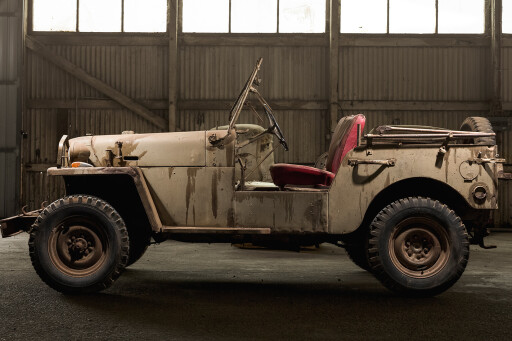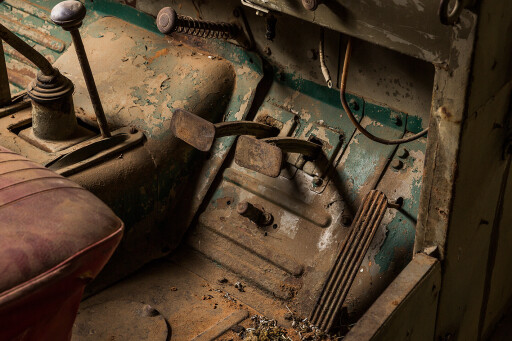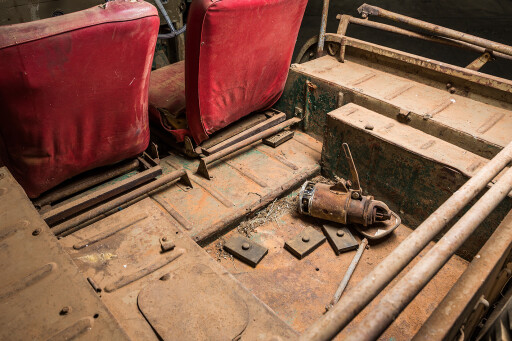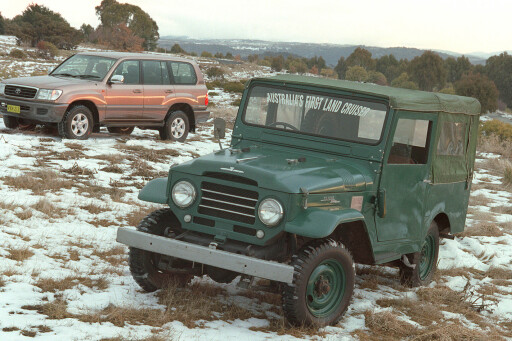
THIS IS a Toyota BJ, effectively a ‘Land Cruiser’ from a time before Toyota even coined the name Land Cruiser.
It was one of 298 made in 1953, and it was imported by B&D Motors of Melbourne as a used vehicle in 1956.
This story starts well before this example of the Toyota BJ arrived in Australia, and has its origins in the US occupation of Japan following World War II. In that time, the US completely restructured Japan politically, socially and economically – in many ways to mirror the US itself.
 Crucial to the Land Cruiser’s origins was the Korean War that broke out in 1950. With the US looking to ramp up production of all things military to support the United Nations-led effort against North Korea and its allies China and Russia, the Jeep, one of the heroes of WWII, was a priority.
Crucial to the Land Cruiser’s origins was the Korean War that broke out in 1950. With the US looking to ramp up production of all things military to support the United Nations-led effort against North Korea and its allies China and Russia, the Jeep, one of the heroes of WWII, was a priority.
VIDEO: Land Cruiser Heritage Museum
With US production of Jeeps under pressure, the US military asked Toyota and Nissan to design a Jeep alternative that could, at the very least, serve Japanese domestic needs, which the Jeep currently filled and, if need be, supplement the Jeep in Korea.
 The first prototype, dubbed the Toyota Jeep (later called the BJ for B-engine Jeep), was developed in early 1951 using the chassis of the SB-Series 1-ton truck. It added a second driven axle utilising a part-time single-speed transfer case.
The first prototype, dubbed the Toyota Jeep (later called the BJ for B-engine Jeep), was developed in early 1951 using the chassis of the SB-Series 1-ton truck. It added a second driven axle utilising a part-time single-speed transfer case.
Paired with a six-cylinder B-type 3.4-litre diesel engine, which was more than three times larger than the SB truck engine, the BJ had little need for a low range transfer case, instead utilising a low first gear.
The US military did not take up the BJ, but a second prototype completed by July 1951 caught the attention of the Japanese National Police Agency (NPA), which until then had relied on the Jeep.
 The NPA were seeking a Japanese-built vehicle, and tested the BJ extensively on the popular hiking trails of Mount Fuji. It proved itself as it climbed to the 6th Hill Station piloted by Toyota test driver Ichiro Taira, achieving notoriety as the first vehicle to do so. Impressed by the BJ, the NPA ordered 289 units a month as its patrol vehicle.
The NPA were seeking a Japanese-built vehicle, and tested the BJ extensively on the popular hiking trails of Mount Fuji. It proved itself as it climbed to the 6th Hill Station piloted by Toyota test driver Ichiro Taira, achieving notoriety as the first vehicle to do so. Impressed by the BJ, the NPA ordered 289 units a month as its patrol vehicle.
2017 Toyota Land Cruiser 79 GXL Single-Cab departs the shed
Over the next two years, during which specifications and production was refined, the chassis was made in Toyota’s plant in Honsya, with final assembly at Arakawa Body in Kogyo.
The 1953 NPA fulfillment was followed by additional orders from the forestry and agricultural industries, as well as private companies within Japan, as Toyota expanded the line to create a cab-chassis (BJ-J) for building fire engines.
 A year later, in June 1954, Willys filed trademark violations against Toyota for the use of the Jeep name. Toyota’s Hanji Umehara renamed the vehicle as the Land Cruiser, and publicly apologised to Willys.
A year later, in June 1954, Willys filed trademark violations against Toyota for the use of the Jeep name. Toyota’s Hanji Umehara renamed the vehicle as the Land Cruiser, and publicly apologised to Willys.
Taking a cue from the Land Rover, Umehara recalls he wanted a name “that would not sound less dignified than those of our competitors.”
Along with the new name, the F-Type 3.4-litre petrol engine joined the B-type diesel and the name FJ Cruiser was created. This also marked the point when the Land Cruiser switched to mass production, as earlier models were built on a made-to-order or contract basis.
 In 1955, a second-generation model called the 20 Series was developed with a less militaristic look and added driving comfort to appeal to civilians and industrial customers.
In 1955, a second-generation model called the 20 Series was developed with a less militaristic look and added driving comfort to appeal to civilians and industrial customers.
Jaguar Land Rover opens the doors to its Classic Works facility
It still retained a rugged appearance, however, while the engine was moved forward to create more legroom. It had a more comfortable ride, with the addition of longer leaf springs and more interior space by moving the steering column to the edge of the dashboard.
Through most of the versions, the engine, transmission, transfer case and final drive were basically the same and interchangeable with only few exceptions.
 While the canvas-top FJ25 was positioned as the standard for export, there were 10 variations created over the next three years, ranging from the FJ20 through to the FJ29 on two separate wheelbases (2285mm and 2430mm). And, for the first time, doors, a metal roof, and even a Nippon-Denso air-conditioning unit was offered.
While the canvas-top FJ25 was positioned as the standard for export, there were 10 variations created over the next three years, ranging from the FJ20 through to the FJ29 on two separate wheelbases (2285mm and 2430mm). And, for the first time, doors, a metal roof, and even a Nippon-Denso air-conditioning unit was offered.
From 1956, Toyota’s strategy was to shift from vehicles manufactured for local needs to the ‘Land Cruiser Strategy for Foreign Markets’.
With the Land Cruiser’s ability to hold its own against the Willys Jeep and the Land Rover, the Land Cruiser was exported to places like Brazil, Saudi Arabia and eventually Australia.
EARLY HISTORY OF LANDCRUISER IN AUSTRALIA
IN 1957, B&D Motors became the official distributor of Toyota in Australia, importing the FJ25 and FJ28 mid-wheelbase chassis models with bodies made by Ansair; although, Rayson Industries in Niddrie, Melbourne, reportedly made some.
Things took a significant turn when industrialist Leslie Thiess (later Sir Leslie) noticed a Land Cruiser while in Japan overlooking coal-mining operations. Seeing how rugged the Land Cruiser was, he wanted them for large civil engineering projects his company was undertaking in Australia.
Land Rover Classic reveals Reborn models
Toyota advised Thiess he would have to go through the existing distributor, B&D Motors in Melbourne, and Thiess purchased 13 Land Cruisers in 1958 to work on the Snowy Mountain Hydro-Electric Scheme in southern NSW. Over the next 20 years, Land Cruisers were then used in various mining and infrastructure projects taken by Thiess.
Still, the Land Cruiser had a long road ahead of it. In 1958, Land Rover was the sales leader with 2087 units sold, with Jeep well behind at 522 sales (helped by a Jeep assembly plant in Brisbane). Land Cruiser, with only 22 sales for the year, was a very distant third.
 The following year saw slow sales growth for the Land Cruiser, but things started to change when Thiess secured Queensland distribution for Land Cruiser from B&D Motors and, with 13 dealers, half of the 69 Land Cruisers sold in 1959 headed to Queensland. Thiess expanded its network in 1960 to become distributors for NSW and Papua New Guinea.
The following year saw slow sales growth for the Land Cruiser, but things started to change when Thiess secured Queensland distribution for Land Cruiser from B&D Motors and, with 13 dealers, half of the 69 Land Cruisers sold in 1959 headed to Queensland. Thiess expanded its network in 1960 to become distributors for NSW and Papua New Guinea.
The sales of Land Cruisers climbed, but Thiess wasn’t happy with the quality of the bodies being fitted to the FJ28s, and Toyota wasn’t impressed by the poor sales in Australia compared to sales elsewhere in the world.
The announcement of the Nissan Patrol being manufactured in Sydney urged Thiess and Toyota to come up with a new plan, and in May 1960 Thiess travelled to Japan and signed a two year agreement with Toyota to become the exclusive distributors for Toyota in Australia and Papua New Guinea.
Classic 4x4: 1956 Series 1 107 Land Rover Station Wagon
In 1960, the 40 Series came along, redesigned from the suspension up with longer springs, rubber bushings on the shackles and all paired to a stronger chassis designed to dampen vibrations before they made it to the body, all in the name of comfort.
Toyota added a new 3.9-litre F-Type engine with 93kW, and for the first time paired to a low range transfer case, but still utilised the three-speed gearbox.
The body had all-new sheet-metal and the wide horizontal grille with Land Cruiser stamped along the top. By 1962, Thiess was selling a full line-up of Land Cruisers, including the FJ40, FJ43 and FJ45 Cruiser, alongside other Toyotas, and by 1965 reached more than $1million in sales, with 50 per cent of Toyota’s sold being Land Cruisers.

COMMENTS